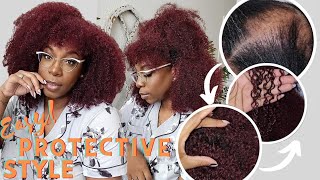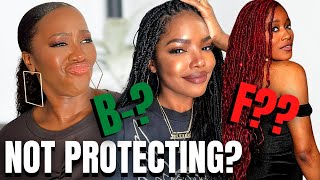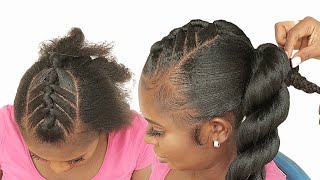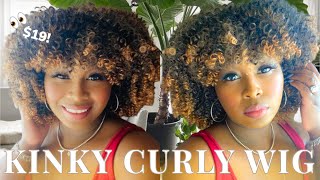4 Protective Styling No-Nos We Need to Seriously Think About
 Protective styles are the perfect time to give our natural hair a break, and they give us the option to play with extension hair instead. However, just because protective styles are a chance to ‘protect’ our tresses, we can’t just install box braids and not touch them again for a month and a half.
Protective styles are the perfect time to give our natural hair a break, and they give us the option to play with extension hair instead. However, just because protective styles are a chance to ‘protect’ our tresses, we can’t just install box braids and not touch them again for a month and a half.
We still need to care for our hair underneath our protective style. If we don’t, it’s counterproductive because our hair will remain the same length, and even become dry and hard to manage once the style is out.
If you have been protective styling and you notice that your hair isn’t getting healthier or its kind of at a stand still, you may not be caring for your hair correctly. Below are four protective styling no-nos that you may do without even realizing!
Getting a style installed too tightly
One thing about protective styles is that they can take a while to install, depending on the style you choose. So of course you want to prep your hair by getting as close to the root as possible.
The bad thing about installing a style too tightly is that it can pull on our hair and cause it to thin, especially if you’re adding heavy extension hair on top.
Be extra careful when installing styles like box braids, weaves*, and crochet braids. If you get it done professionally, ask the hair stylist to braid a little looser.
That way, the skin on your face won’t be stretched out, you won’t have a headache (both things that have happened to me), and your edges will still be intact.
Not washing/maintaining hair underneath
Just because your hair is tucked away, doesn’t mean that you don’t have to wash it. A clean scalp is a healthy scalp. If you don’t wash your hair for the entire time that you have a protective style, you’re actually making it more difficult for your hair to grow, because it can’t get past all of the dirt and bacteria.
I’ll admit, it’s a little harder to wash hair underneath a protective style, but it can still be done. If you have a weave* or box braids, you can invest in a small applicator bottle*.
Fill it with water and shampoo and apply it to your scalp, between the braids/tracks. Massage your scalp gently and rinse using the same applicator bottle* (this time filled with water only). Repeat with conditioner. Even if you don’t wash as often as your normal hair regimen, try to wash your hair every so often to keep it clean (and smelling nice!).
 Not wrapping hair at night
Not wrapping hair at night
I’m definitely guilty of this during my everyday life, but it’s important to wrap up your hair at night when you have a protective style.
If you sleep on a cotton pillowcase, it will rub against your style, drying it out or even causing it to become fuzzy over time. If you want your protective style to last for more than a few days, figure out the best way to preserve it.
Invest in either a satin pillowcase*, satin bonnet*, or silk scarf*. Depending on the style you have, decide how to maintain your hair with these tools.
Refrain from using tight scrunchies or hair ties* (which can pull at your edges). Instead, either let your hair go free, wrap it, or braid it at night to keep it neat. Preserving your hair at night is a key tip to getting the most time out of your protective style. You want to adapt your regimen to include the extension hair, which may have to be treated a little differently.
Installing protective styles back to back
Installing protective styles back to back means that you took out one style and got another one installed immediately after.
Although you may be on a protective styling wave, immediately restyling hair doesn’t give your natural hair a chance to ‘breathe’, and the strands may be a little weak.
Give yourself a short break between protective styles. After taking a style down, treat your hair to a wash and deep condition.
Restore the moisture in your strands and seal using the LOC method, especially if your hair seems dry after taking down your style. Leave your hair out for a few days before protective styling again. That way it can have a little time to flourish before being braided back up.
Protective styling is a major time saver if done correctly. If you’ve done any of the above, don’t feel bad- it happens to the best of us.
However, now you can get the most out of your protective style while caring for your strands underneath. Treat both your extension hair and your natural hair the right way and they will definitely cooperate. By not doing these things, you have the opportunity to retain length and see the growth that you want!
What’s your best protective styling tip?




